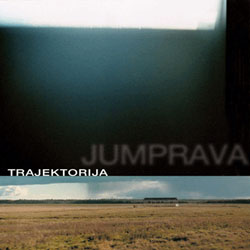
I find it extremely difficult to leave a record store without buying anything. Sometimes I feel like I have to justify the time spent in the store browsing and listening by having something to show. It’s a problem that’s especially severe in Latvia, so I have many šlāgermūzikas tapes to show for my troubles.
Sometimes I will pick up something that I really had no interest in buying, and it turns out I will really like it. This happened in 1998, when I was in a record store in Rīga, had no idea what to buy, but knew I couldn’t leave empty-handed. I spotted a compact disc by Jumprava, Laika atšķirību romance, and picked it up on a whim.
I had heard a few of their songs before then, like the quirky “Peldētājs” and the keyboard-heavy “Ziemeļmeita,” but had no idea what to expect of the album. Much to my surprise, it became one of my all-time favorites. From the opening track, “Pastorāle,” to the Indian-influenced “Jaganatha,” the album rarely left my CD player.
The late 1990s saw many Jumprava-related releases. After Laika atšķirību romance, Platforma Records in 1999 released a Jumprava best-of CD, Labāko dziesmu izlasem, which also became one of my favorites because it gathered into one place the earlier Jumprava songs that I had scattered over multiple tapes and records. The year before, Jumprava founder, guitarist and vocalist Aigars Grāvers released his collection Pret vēju pēc 90-ta, which gathered together a number of songs from the various bands he played with. In 2000, Grāvers and Latvian poet Nataradža collaborated on the Rama Dance project, Sāga. Both Grāvers and Nataradža were influenced by Indian culture and folklore and the album bore the fruits of their efforts, combining Sanskrit, Latvian and plenty of keyboards to produce another excellent and unique album.
After all that, Jumprava returned late last year to deliver an entirely new album called Trajektorija. I was very curious what it was going to sound like. Was it going to be more like Rama Dance or Laika atšķirību romance, or was it going to sound completely different?
I must say I wasn’t expecting what I heard. However, after a few listens this album really grew on me and I believe it has become a very worthy addition to the Jumprava catalogue. This release will find its way into my CD player quite often, even in the distant future, which is a testament to its staying power.
Though the participants on the album are not listed anywhere in the liner notes, Jumprava’s lineup has not changed: Aigars Grāvers, Aigars Grauba, Aigars Krēsla and Ainārs Ašmanis make up the band. Nataradža also returns to provide lyrics to a number of the songs.
Many of the tracks on the album strike me as classic Jumprava, and some were a bit unsettling to hear at first. I wondered, “Does anyone actually play bass or guitars or drums on this album, or is it all synthesized?” However, because Jumprava have always been a synthesizer-intensive group, the less-organic feeling of the album can be forgiven.
A reoccurring theme over the course of the album is flight. This is first made clear in the opening song, “Lidosta mehāniskiem putniem.” Heavy on electronics, the opening beats of this song sound like an airplane getting ready to take off. The song makes for a great start to the album.
Next up is “Dzinējsuns,” the most techno-sounding song on the album. This one is a bit too techno for me. It reminds me of the frantic music in those Mortal Kombat video games. It also features practically “rapped” verses, presumably by Grāvers.
A favorite on the album is “Divi putni.” Cheesy 1980s-sounding keyboard intro aside, this up-tempo and hard-driving track features some great vocals and lyrics by Nataradža.
Another favorite on the album is the more somber “Anastasijas vārdi.” The track features a number of effects adding to the rather “mysterious” sound of the song.
The song “Baiga vasara” is from Grauba’s film of the same name set in Latvia during World War II. It features lyrics like “Ja lūdzam ar noliektu galvu, vai eņģeļi sadzirdēs mūs?” (If we pray with bowed heads, will the angels hear us?). Though the song is bleak, some hope remains.
The song I liked the most is the last one, “Nedaudz par viņu,” written by Grauba. Out of all the songs on the album, it best displays the Jumprava sound. Painted in both broad and fine musical strokes, the song has a rather simple keyboard part that is very involving. Grauba’s practically pleading vocals are also memorable, as he sings “Mīļā, kāpēc es neredzu savadāk?” (My love, why do I not see differently?). It’s definitely a classic Jumprava song.
Combining elements of Rama Dance, their most recent recordings, as well as their classics, Trajektorija is another great album from Jumprava. Don’t let the heavy synthesizers and downright techno sounds discourage you. Jumprava are still at the peak of their creativity and songwriting skills.
Details
Trajektorija
Jumprava
Platforma Records, 2001
© 1995-2024 Latvians Online
Please contact us for editorial queries, or for permission to republish material. Disclaimer: The content of Web sites to which Latvians Online provides links does not necessarily reflect the opinion of Latvians Online, its staff or its sponsors.




